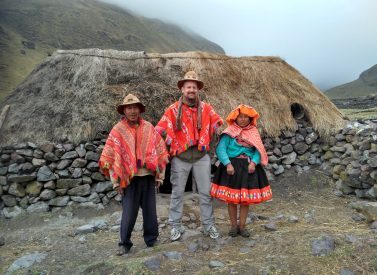Know Before You Go: Peru Trekking and Hiking Travel Tips
 by Tom Shearman on 7th November, 2023
by Tom Shearman on 7th November, 2023

Peru Trekking and Hiking Travel Tips
Peru, one of the most diverse Andean nations, offers a feast of trekking and hiking routes that showcase the country’s beauty.
The Andes Cordillera runs the length of Peru. Its soaring peaks and satin-white glaciers frame many trekking routes as they course through remote villages, many unchanged since Inca times.
Trekking in Peru is a rewarding challenge for all hiking levels. This indispensable guide to hiking in Peru will highlight the routes, training, and demands of walking through some of the world’s finest mountains.

What Are the Best Treks in Peru?
The best hiking trails in Peru cover the country. Here are our favourites, starting in the south of the country. The stated duration doesn’t include acclimatisation time.
- Inca Trail (2-5 days)
- Colca Canyon (3 days)
- Choquequirao (5 days) or 7-8 days if continuing to Machu Picchu
- Huchuy Qosqo (3 days)
- Lares (3-7 days)
- Salkantay Trek (4-7 days)
- Ausangate (5 days)
Other famous day treks in the south include Rainbow Mountain, hikes in the Machu Picchu ruins (Huayna Picchu, Machu Picchu Mountain, and Huchuy Picchu), and the volcanoes of Arequipa, such as Ampato.
In the north, the main trekking centre is Huaraz. From here, there are three gorgeous mountain ranges to explore: Cordilleras Blanca and Negra and the Cordillera Huayhuash. The top treks around Huaraz include:
- Cordillera Huayhuash (9-12 days)
- Santa Cruz (5 days)
- Laguna Churup (1 day)
- Cordillera Blanca (6-9 days)
- Climb Pisco (3 days)
- Alpamayo (7-9 days)
Away from Huaraz, fantastic walks in the north include Gocta Waterfall (2-4 days) and Chachapoyas (5-9 days).

Planning Your Peru Trekking Holiday
Take the following into consideration when planning your Peru hiking holiday.
Season: The primary trekking season is April to October during the Andean winter. Skies tend to be clear, and there is little rain, albeit an afternoon shower is always possible in the high mountains. Treks at lower altitudes, like the Inca Trail and Colca Canyon, may run year-round.
Permits: Inca Trail trekkers require a permit. Spaces are limited, and they sell out many months in advance, especially during the peak season of May to August. Most other treks can run at any time during the appropriate season.
Training: High altitude, multi-day treks require you to be in good physical condition. If needed, get fit many months in advance so you’ll spend your trekking tour enjoying the views and not grumbling about how hard it is.
Acclimatise: Build in acclimatisation to high altitude before starting any trek. We can help with this. For example, it’s good practice to spend three nights sleeping in Cusco (3,400m) before beginning the Inca Trail. Use those acclimatisation days to walk to higher altitudes, then sleep back in Cusco.
Kit: Don’t arrive in Peru with new and untested kit. Buy good quality clothing and test it out in all conditions before setting off on holiday.
Coca leaves: Chewing these and drinking coca tea in Peru can help you acclimatise.
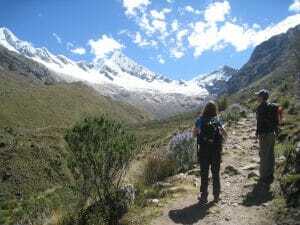
How To Train for the Inca Trail and More Peru Treks
There’s no better practice for a Peru trekking holiday than donning your backpack and heading out for walks. Up and down hills, mountains, and oscillating coastal paths are perfect for replicating the uphill pulls in the Andes.
Walking will build up your stamina. Start with short walks and build up to half-day (2-4 hours), then full-day (6-8 hours) adventures. Aim to go on a few multi-day hikes; weekends away are perfect. Pack a daypack with what you expect to carry in Peru: food, water, sun cream, jackets, toilet roll, etc, aiming for 5-7kg (11-13lbs).
Add in camping to fully prepare yourself for the conditions. Some people love sleeping under canvas, while others require a little adaptation. Find out what works for you.

City dwellers unable to escape the urban sprawl can practice walking up and down stairs multiple times, listening to tunes, or walking home, finding new routes.
Hiking practice is ideal for breaking in your new kit, particularly hiking boots and walking poles, if you plan to use them. Experiment with snacks and find which ones you like and are easy to carry; you’ll need some in Peru. Remember: a hungry hiker is not a happy hiker.
All this practice will prepare you for one of the most important aspects of mountain treks: staying positive. A can-do attitude is vital in the hills because things do go wrong. Laces break, snacks get soggy, and legs tire. That’s part of the challenge that makes it so enjoyable. A smile is one of the best salves.
(NOTE: For all hikes, always plan routes, take maps, research the weather and area and let someone know where you are going).
Should I Do Gym Work To Train for a Trek?
Complement walking with core-building exercises like swimming, gym work, and yoga. Always ask a professional trainer for advice, but some good exercises include:
Lunges, deadlifts, squats, and the step machine.
Running is perfect for increasing stamina. But always keep walking as the prime exercise type. You need to mimic conditions as closely as you can for what could be 4-12 days of consecutive hiking.

How Do I Acclimatise for a High-Altitude Trek?
Being anywhere over 2,500m/8,200ft can induce altitude sickness or AMS.
Building in sufficient high-altitude acclimatisation is crucial to completing any high-altitude trek in Peru, from a day hike to the Inca Trail or the longer Cordillera Huayhuash.
How much acclimatisation depends on how high you go and how quickly. Some treks see you acclimatise as you move along, with the highest pass or peak towards the trek end, when you should be well adjusted.
Most hikes will require 2-4 days at high altitudes before setting off on a walking tour. Everyone acclimatises at different speeds. Here are some tips:
- Eat light meals
- Avoid caffeine and alcohol; stick to coca tea and drink two to four litres of water daily.
- Move slowly and avoid sudden movements that may take your breath away.
- Don’t go straight from sea level to anything above 3,800m/12,467ft.
- Climb high but sleep low. Once above 3,000m, don’t increase your sleeping altitude by more than 300-500m (985/1,640ft) each night.
- Observe your body, and don’t push yourself.
Altitude sickness symptoms include:
- Headache
- Nausea and vomiting
- Loss of appetite
- Light-headed feeling
- Dizziness
- Drowsiness and feeling tired/lethargy
- Struggling/breathlessness if running up a hill or climbing stairs too quickly
Remember, you will acclimatise with patience and by following the advice. And always be prepared to come down or turn back if you have any doubts.
Read Kathy’s acclimatisation blog for more.
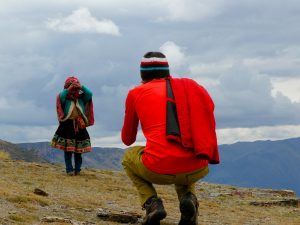
A Typical Day While Hiking in Peru
Trekking life is a beautifully simple one. Awake in stunning mountain scenery, eat well, and hike through picture-postcard landscapes to the following fantastic campsite. Wildlife, views, and the space only mountain ranges can proffer are your companions.
A typical day hiking in the Peru mountains means an early start, often around 6 a.m. A hearty breakfast in the dining tent could include porridge, toast, pancakes, and hot drinks.
Porters pack all the communal kit away while you head off with the guide on the day’s path, usually between 7–8 a.m. You may walk for 3-4 hours in total in the morning, with stops, before taking a lunch break. Lunch could be a packed lunch of sandwiches, cheese, crackers, fruit (if possible) and chocolate bars. On some trips, the porters cook up something tasty on the hillside.
There’s another 3-4 hours to cover in the afternoon. Most guides aim to get you to camp around 4–5 p.m. The porters will have set up a dining tent and your tent. That gives you time to relax, take on some hot drinks and snacks, and reflect on the day’s journey.
A hot and filling evening meal is served around 7–7.30 p.m. It does get cold in the high Andes, so some people retire to bed early, while others may stay in the dining tent socialising. The stars are striking from most camps and well worth a gaze.
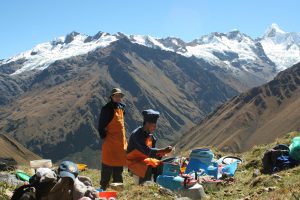
Hints and Tips:
- Drink plenty of water; boiled and treated water is supplied.
- Eat regularly and have plenty of snacks available. Bring your own to supplement those provided.
- Be kind to your feet.
- Walk at your own pace.
- Take time to enjoy your surroundings and take photos.
- Keep sun cream, toilet roll, and handwash within reach at all times.
- Trekking hats are perfect to combat the intense Andean sun.
- Learn some Spanish before starting so you can greet any locals you encounter.
When’s the Best Time to Trek in Peru?
The primary trekking season for most of Peru is from May to September. Climate change means the shoulder months of April and November are increasingly suitable for hiking. Note that the Inca Trail is closed in February for maintenance.
The climate depends mainly on altitude.
As a rule of thumb, below 2,000m climate is mild and above 2,000m, warm clothing is required for evenings, nights and early mornings. The Andean sun is powerful wherever you are.

Peru Trekking: May to October (dry season)
Cusco (3,300m): Ave max/min temps: 22°C/2°C. Average 3 or 4 wet days per month.
On highland treks, expect a range of conditions within a single day:
- Cold/freezing nights at camps above 4,000m, where pre-dawn temperatures can reach -5°C
- Warm, spring-like mornings and afternoons and chilly evenings.
Mountain weather can be fickle and localised, and precipitation is not unknown in the dry season. Expect temperatures to swing between sun and shade, sheltered and exposed ground and with altitude gain and loss.
A quick-setting sun means temperatures drop fast. Conditions are generally dry.
Peru Trekking: November to March/April (wet season)
Cusco: Average max/min temps: 23°C/6°C. Average 13 wet days per month.
On highland treks, there are wetter conditions, with cooler days and milder nights than the dry season. January to March are usually the wettest months. Most of the rain falls in the afternoon, so treks tend to start early and aim to get to camp before any showers come in.

What Kit Do I Need for Hiking in Peru?
Some of our treks include sleeping bags and thermarests, and others don’t. Please ask.
When planning for the climatic conditions encountered while hiking in the High Andes of Peru, layering is the most practical and versatile clothing system. It’s worth remembering that our clothing keeps us warm by retaining and isolating the heat we create.
To best maintain body heat, several layers of lightweight, warm and quick-drying clothing are far more efficient than one or two thick layers. Layers should have the following qualities:
- Breathability (able to wick away the humidity produced by sweat):
- Isolation (able to keep in the warm air our body has); and
- Impermeability (able to impede the passing of wind and water).
First (base) layer: This layer wicks the sweat away from our skin, thus helping keep the body dry and warm. To this end, synthetic fabrics such as polypropylene should be used.
Mid-layers: These isolating layers should also be synthetic (e.g., the known polar linings such as Polartec or Windblock, which are light and insulate twice as well as wool)—fundamental layers for retaining body heat.
Outer layer/shell: Finally, the vital layer which protects us from climatic adversities. A breathable, wind-proof and waterproof anorak, such as Goretex.
Most high-altitude trekking teams carry an extensive first aid kit & oxygen for emergencies only. Non-personal trekking camping gear , like tents, cutlery, etc, is provided.
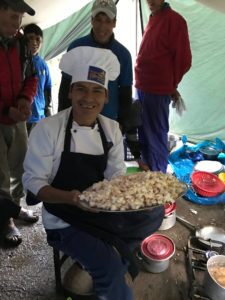
Detailed Trekking Kit List for Peru
- 2 pairs synthetic inner socks (e.g., polypropylene, thermastat, coolmax)
- 2 pairs thick loop-stitch/wool socks for cold.
- Trekking boots – should be well broken-in, waterproof and provide good ankle support.
- Trainers/sandals for city wear, evenings at lower camps & river crossings.
- Base layer leggings (1 pair).
- Thick fleece leggings (or salopettes) (1 pair).
- Goretex-type over-trousers (or salopettes) (1 pair).
- Trekking trousers (2 pairs).
- Shorts – wear sparingly in the early stages at altitude, as the sun burns.
- Thermal base layer shirts (2).
- Microfleece mid-layer shirt (1).
- Shirt/t-shirt 1 or 2 for lower altitudes. Long-sleeved, collared shirt protects against the sun.
- Fleece jacket or similar (1).
- Warm jacket (down or synthetic). For camp and upper slopes.
- Waterproof Goretex-type jacket.
- Broad-brimmed sunhat is essential.
- Warm hat, fleece or wool. (N.B. Up to 30% of body heat can be lost through the head).
- Sunglasses with UV filter.
- Scarf for cold.
- Bandanna – to protect neck from the strong sun.
- Light inner gloves
- Warm gloves, e.g., fleece and outer waterproof gloves or mittens (1 pair). Mittens allow you to keep the fingers together and better conserve heat.
- Daypack (at least 30 litres). Comfortable and with waterproof lining or cover.
- Pair of telescopic trekking poles (optional, can be rented, please ask). Note: You must have rubber tips on your poles for all Inca Trail treks.
- Duffel bag or large rucksack for extra clothing, carried by horse/mule/porter while you are trekking.
- Water bottle (2 litres approx.) & purification tablets.
- Personal first-aid kit to include painkillers, plasters (band-aids), moleskin, after-bite (tiger balm), anti-diarrhoea tablets, throat lozenges, rehydration salts & personal medication.
- Insect repellent.
- Towel & wash-kit.
- Wet wipes/antiseptic handwash cream.
- Sunscreen (factor 50+) and lip salve.
- Head lamp (plus spare bulb and batteries).
- Penknife.
- Camera and film/memory cards (take at least twice the amount you think you will need!).
- Book, e-book, mp3 player/iPod or other for free time.
- Binoculars.
- Spanish/English phrasebook.
- Extra snacks, e.g., cereal bars or favourite chocolate bars.
Miscellaneous other trekking kit
- Money belt.
- Passport plus a photocopy of your passport.
- U.S. dollars cash, mixed-denomination notes, undamaged and unmarked.
- ATM cash/credit card.
- Any necessary inoculation certificates.
- Personal & medical insurance certificates.
- Comfortable clothes for travel, smart clothes for nightlife.

Extra Reading: Peru Trekking and Hiking Travel Tips
Now, you’re all set with everything you need to know before trekking in Peru. Remember to check these superb supplementary trekking blogs:
- Get fit for your hiking holiday
- Top tips for trekking in the Andes mountains
- Prepare for the Inca Trail
- Why Peru is the best trekking destination in South America
Have you been inspired? Contact us for more about the best Peru trekking trips.



 a Group Tour
a Group Tour  a Tailor Made Tour
a Tailor Made Tour 





